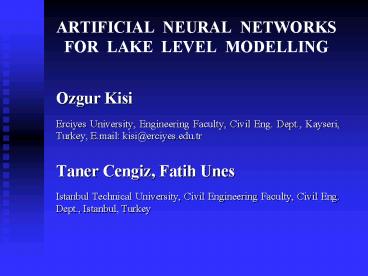ARTIFICIAL NEURAL NETWORKS FOR LAKE LEVEL MODELLING - PowerPoint PPT Presentation
1 / 18
Title:
ARTIFICIAL NEURAL NETWORKS FOR LAKE LEVEL MODELLING
Description:
The results of ANN, AR and MLR were compared according to the MSE, MARE and R criteria. ... The MARE of each model in testing period. Fig. 2a. ... – PowerPoint PPT presentation
Number of Views:131
Avg rating:3.0/5.0
Title: ARTIFICIAL NEURAL NETWORKS FOR LAKE LEVEL MODELLING
1
ARTIFICIAL NEURAL NETWORKS FOR LAKE LEVEL
MODELLING
- Ozgur Kisi
- Erciyes University, Engineering Faculty, Civil
Eng. Dept., Kayseri, Turkey, E.mail
kisi_at_erciyes.edu.tr - Taner Cengiz, Fatih Unes
- Istanbul Technical University, Civil Engineering
Faculty, Civil Eng. Dept., Istanbul, Turkey
2
INTRODUCTION
3
It is necessary to develop models for simulation
of the extreme or abnormal level variations in
order to control future level changes_in_a_lake.
Level measurements or their future equally
likely replicas obtained through a simulation
model are a direct way of obtaining_lake_managemen
t_decision_variable.Although it is possible to
identify sophisticated models taking into
consideration the hydrological and hydro
meteorological variables such as the
precipitation, runoff, temperature and
evaporation, it is economically preferable if a
model that simulates the level variations on the
basis of past level records (Sen et al., 2000).
4
Slivitzky and Mathier, 1993Hubert et al.,
1989Vannitsem and Demaree, 1991Sneyers,
1992Kite, 1990, 1992Meshkani and Meshkani,
1997Sen et al., 2000Jury and Gwazantini,
2002).
5
NEURAL NETWORKS
6
Figure 1. Configuration of three-layer neural
network
7
Each neuron in layers j and k receives the
weighted sum of outputs NET from the previous
layer as input. As an example, NET for layer j is
given by
(1)
where ?j a bias, or threshold value, for neuron
j, that is trainable by treating it as a weight
Wj in product with an output Op set equal to 1.
Each neuron in layers j and k produces its output
by passing its value of through a non-linear
activation function. A commonly used functional
form is the logistic activation function
(2)
8
The total error Ep, based on the squared
difference between predicted and actual outputs
for pattern p, is computed as
(3)
The goal of the training process is to present a
sufficient number P of unique input-output
pattern pairs, which when coupled with a suitable
methodology for iterative correction of the
interconnection weights, produces a final set of
weights that minimizes the global error, E,
defined as
(4)
9
APPLICATION AND RESULTS
10
Table 1. The statistical parameters of lake level
data
11
The input combinations of lake level data
evaluated in the present study are 1) Lt-1 2)
Lt-1, Lt-2 3) Lt-1, Lt-2, Lt-3 4) Lt-1,
Lt-2,..., Lt-4 5) Lt-1, Lt-2, ..., Lt-5 6)
Lt-1, Lt-2, ..., Lt-6. The output layer had one
neuron for current lake level Lt. Two and
three-layered ANN were applied to each input
combinations. The AR and MLR were also applied to
the same data combinations. The results of ANN,
AR and MLR were compared according to the MSE,
MARE and R criteria. The MSE and MARE are defined
as
(10)
(11)
where N and Yi denote the number of data sets and
lake level data, respectively.
12
Table 2. The MSEs and correlation coefficients
of each model in testing period
13
Table 3. The MARE of each model in testing period
14
Fig. 2a. Comparison of ANN and AR or MLR
estimates with the observed lake levels in the
form of hydrograph.
15
Fig. 2b. Comparison of ANN and AR or MLR
estimates with the observed lake levels in the
form of scatterplot.
16
CONCLUSIONS
17
- The ANN1 and ANN2 input nodes consisting of Lt,
Lt-1,, and Lt-6 provided the best match among
the combinations tried
- In general, both the ANN1 and ANN2 gave better
forecasts than the AR and MLR. ANN2 had better
forecasting performance than the ANN1 for the all
input combinations tried in the study.
- Based on these results, it is clear that the ANN
technique is capable of modelling a lake level
fluctuation.
- The study only used data from one area and
further studies using more data from various
areas may be required to strength these
conclusions
18
Thanks for your patience

